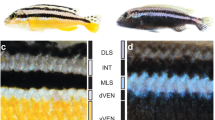Abstract
The patterns of coloration of fishes, and the rapid changes of these color patterns in some species, are due to the presence and cellular activity of pigment-containing cells located in the integument. These highly specialized cells, collectively referred to as chromatophores, are capable of changing body coloration of the animal by virtue of two different mechanisms. In the first, chromatophores may actively redistribute pigment-containing organelles within the cell boundary in such a way that more or less of the pigment organelles are exposed to view. These changes can be rather prompt, being mediated, in many cases, through the activity of nerve endings that directly stimulate the chromatophore. If the activities of many cells are spatially and temporally coordinated, the macroscopic effect can be rather dramatic in that it produces changes in overall body coloration or pattern. Examples include the adaptive coloration of fishes in response to background or changing light conditions, or the display of color patterns reflecting and signaling mood or physiological state of the animal. Thus flounders placed in an aquarium with a checkerboard bottom will attempt to mimic this pattern in their dorsal body surface, and rivaling angelfish fighting for a mate will develop pitch-black stripes running down their flanks. These phenomena reflect an alteration in the physiological state of their pigment cells and therefore are referred to as “physiological color change”. A different mechanism of changes in body coloration, termed “morphological color change”, is based on a much slower, long-lasting process that involves either a decrease or an increase in the total number of pigment cells or the amount of pigment they contain. Such changes are gradual and not easily perceived, but the result may be quite dramatic once the transition from one state to the other, which takes several days or weeks, is completed. As a rule, both morphological and physiological color change occur simultaneously, with the former providing the baseline coloration upon which fine-tuned responses of the animal to internal or external stimuli are superimposed.
Access this chapter
Tax calculation will be finalised at checkout
Purchases are for personal use only
Preview
Unable to display preview. Download preview PDF.
Similar content being viewed by others
References
Armstrong PB (1980) Time-lapse cinemicrographic studies of cell motility during morphogenesis of the embryonic yolk sac of Fundus heteroclitus (Pisces: Teleostei). J Morphol 165: 13–29
Bagnara JT, Hadley ME (1973) Chromatophores and color change. Prentice Hall, Englewood Cliffs
Bagnara JT, Taylor JD, Hadley ME (1968) The dermal chromatophore unit. J Cell Biol 38: 67–79
Bagnara JT, Matsumoto J, Ferris W, Frost SK, Turner WA, Tchen TT, Taylor JD (1979) Common origin of pigment cells. Science 203: 410–415
Fox DL (1976) Animal biochromes and structural colors. Univ of California Press, Berkeley
Fox HM, Vevers G (1960) The nature of animal colors. Sidgwick and Jackson, London
Fujii R (1969) Chromatophores and pigments. In: Hoar WS, Randall DJ (eds) Fish physiology, vol III. Academic Press, New York, p 307
Fujii R, Novales RR (1969) Cellular aspects of the control of physiological color changes in fishes. Am Zool 9: 453–463
Lamer HI, Chavin W (1975) Ultrastructure of the integumental melanophores of the coelacanth, Latimeria chalumnae. Cell Tissue Res 163: 383–394
Lethbridge RC, Potter IC (1981) The skin. In: Hardisty MW, Potter IC (eds) The biology of lampreys, Academic Press, London New York, p 377
Luby-Phelps K, Porter KR (1982) The control of pigment migration in isolated erythrophores of Holocentrus ascensionis (Osbeck). II. The role of calcium. Cell 29: 441–450
Lynch TJ, Lo SJ, Taylor JD, Tchen TT (1981) Characterization of and hormonal effects of subcellular fractions from xanthophores of the goldfish, Carassius auratus L. Biochem Biophys Res Commun 102: 127–134
Odiorne JM (1957) Color changes. In: Brown ME (ed) The physiology of fishes, vol II. Academic Press, London New York, p 387
Parker, GH (1948) Animal color changes and their neurohumors. Cambridges Univ Press, London
Schliwa M (1982) Chromatophores: Their use in understanding microtubule-dependent intracellular transport. Methods Cell Biol 25: 285–312
Schliwa M (1984) Mechanisms of intracellular organelle transport. In: Shay JW (ed) Cell and muscle motility, vol V. Plenum Publ, New York, p 1–82
Schliwa M, Euteneuer U (1983) Comparative ultrastructure and physiology of chromatophores, with emphasis on changes associated with intracellular transport. Am Zool 23: 479–494
Shephard DC (1961) A cytological study of the origin of melanophores in the teleosts. Biol Bull 120: 206–220
Wakamatsu Y (1978) Light-sensitive fish melanophores in culture. J Exp Zool 204: 299–304
Waring H (1963) Color change mechanisms of cold-blooded vertebrates. Academic Press, London New York
Author information
Authors and Affiliations
Editor information
Editors and Affiliations
Rights and permissions
Copyright information
© 1986 Springer-Verlag Berlin Heidelberg
About this chapter
Cite this chapter
Schliwa, M. (1986). Pigment Cells. In: Bereiter-Hahn, J., Matoltsy, A.G., Richards, K.S. (eds) Biology of the Integument. Springer, Berlin, Heidelberg. https://doi.org/10.1007/978-3-662-00989-5_4
Download citation
DOI: https://doi.org/10.1007/978-3-662-00989-5_4
Publisher Name: Springer, Berlin, Heidelberg
Print ISBN: 978-3-662-00991-8
Online ISBN: 978-3-662-00989-5
eBook Packages: Springer Book Archive



